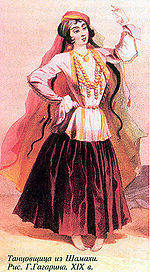This is an old revision of this page, as edited by M.Bitton (talk | contribs) at 16:25, 9 January 2024 (+ lock). The present address (URL) is a permanent link to this revision, which may differ significantly from the current revision.
Revision as of 16:25, 9 January 2024 by M.Bitton (talk | contribs) (+ lock)(diff) ← Previous revision | Latest revision (diff) | Newer revision → (diff)Traditional dress of the peoples of the Caucasus and Iran

An arkhalig is part of both male and female traditional dress of the peoples of the Caucasus and Iran. The arkhalig originated from the beshmet, a Turkic outer clothing later worn by Cossacks.
An arkhalig is a long tight-waist jacket made of various kinds of fabric, such as silk, satin, cloth, cashmere and velvet, traditionally depending on the social status of its owner. Male arkhaligs can be both single-breasted (done up with hooks) and double-breasted (done up with buttons). In cold weather, a chokha is put on above an arkhalig. Female arkhaligs are often ornamented and have tight long sleeves widening on the wrists. A female arkhalig can also include a fur list along the edges, patterned laces and braids, or be decorated with gold embroidery.
In the arkhalıq, there are true sleeves, either cut plain, or plain to the elbow and then slit as far as the wrist or, in the type called lelufar (Persian language, nīlūfar that means lily), flared from the elbow like the bell of a lily and trimmed with an extra 4 cm of lining from the inside.
Arkhaligs were in wide use until the 1920s.
Note
- Template:Lang-hy, Template:Lang-az, Georgian: ახალუხი, Template:Lang-fa
References
- Andrews & Andrews, P. A. & M. "CLOTHING xxi. Turkic and Kurdish clothing of Azerbaijan". Encyclopædia Iranica. Retrieved 2011-10-12.